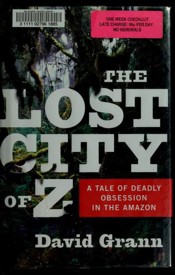The Lost City of Z: A Tale of Deadly Obsession in the Amazon

This is the story of several things, simultaneously.
Most prominently, it’s the story of Percy Fawcett, an explorer from England who ventured into the Amazon twenty-some-odd times. He was utterly convinced there was a lost civilization somewhere therein, which he called “Z”
It’s also the story of the founding of the Royal Geographical Society, which is a group of people who were interested in mapping the world, which was a novel concept in the 19th century.
There’s a subplot of the author’s attempt to figure out what happened to Fawcett, as he himself ventures into the Amazon.
Finally, it’s a larger story about the state of the world in the early 20th century, during the time Fawcett was adventuring.
I’m not spoiling anything by telling you that Fawcett doesn’t make it out from his last adventure. He disappeared in 1920, while searching for the city with his son and his son’s friend. No trace of him was ever found, and there are conflicting stories about what happened to the group of men.
The author tries to figure this out, and he manages to track Fawcett’s last days down to a few hundred yards it seems. But, in the end, all that he finds is speculation (although, educated speculation – local tribes are quite sure what happened to him).
What’s amazing about the book is how obsessed Fawcett was. His family lived in poverty back in England, as he took adventure after adventure into the Amazon. He was sure Z existed, but it seems he was also just addicted to the hunt.
The book makes it clear that exploring in the Amazon was nightmarish. In addition to starving, there are lots of creepy crawly things out that make life difficult. Several dairy entries from a man being eaten alive by flying bugs is hard to read, and on multiple occasions, maggots eat people from the inside out. I can’t imagine why someone would subject themselves to this over and over.
But it was a different time. We have satellites now, and we’ve basically mapped everything on Earth, but back then, things were still discoverable. There were places we didn’t know about. The world was still a mystery.
(It reminded me of the Internet in the 1990s. It was still a mystery back then. We hadn’t mastered it. Now, we own the Internet, and we control it.)
So, did Z exist? Yes, likely, but Fawcett was too obsessed to see it. I won’t spoil that, as it comes together in the last couple of pages, but part of me thinks that Fawcett wouldn’t have admitted that he found it anyway. In the end, he didn’t want to find Z, as much as he just wanted to search for it.
The book is a remarkable portrayal of a man you come to know but never seem to understand.
Postscript
Added on
It appears that Fawcett was right after all, he just might not have been looking in exactly the right place.
The discovery of the Americas’ long-lost ‘Rome’
Using airborne laser-scanning technology (Lidar), Rostain and his colleagues discovered a long-lost network of cities extending across 300sq km in the Ecuadorean Amazon, complete with plazas, ceremonial sites, drainage canals and roads that were built 2,500 years ago and had remained hidden for thousands of years. They also identified more than 6,000 rectangular earthen platforms believed to be homes and communal buildings in 15 urban centres surrounded by terraced agricultural fields.
Book Info
- I have read this book. According to my records, I completed it on .
- A hardcover copy of this book is currently in my home library.